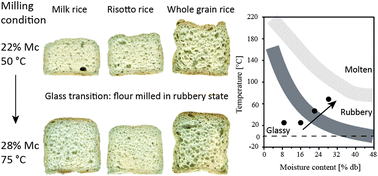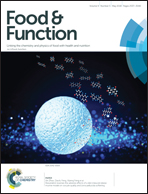Tailoring rice flour structure by rubbery milling for improved gluten-free baked goods†
Abstract
Ever-growing demand for gluten-free products calls for the development of novel food processing techniques to widen the range of existing baked goods. Extensive research has been targeted towards recipe optimization, widely neglecting the tailoring potential of process-induced structuring of gluten-free raw materials. Herein, we address this shortcoming by demonstrating the potential of rubbery milling for the generation of structure and techno-functionality in breads obtained from a variety of rice flour types. Moisture and temperature induced state transitions during milling were exploited to tailor the physicochemical properties of the flour. Moisture addition during conditioning of the different rice varieties and milling in the rubbery state considerably decreased starch damage due to more gentle disintegration. The degree of starch damage dictated the water absorption capacity of the rice flour types. Flour types with reduced starch damage upon milling offered lower dough densities, yielding bread loafs with a higher volume and better appearance. The choice of rice variety enables fine-tuning of the final product quality by influencing the dough viscoelasticity, which defines the final loaf volume. Whole grain rice flour dramatically increased the loaf volume, whilst simultaneously offering nutritional benefits. Combining the proposed functionalised flour types with current and future advances in product recipes paves the way towards optimised gluten-free goods.



 Please wait while we load your content...
Please wait while we load your content...